Alan Cathcart | July 6, 2017
For more than three decades, BMW has consistently been at the forefront of delivering innovative engineering on two wheels—think ABS, Telelever, Paralever, Duolever, C-evolution, K100/K75 ‘Flying Brick’, and so much more. But with the debut of its gorgeous-looking yet ultra high-performance HP4 RACE at last November’s EICMA Milan Show, the German company is now directing its attention towards the use of avant-garde materials aimed at reducing weight on a series production model, and especially carbon fiber. Just 750 examples of this exotic new model will be built, each costing $91,000 and available only in track-ready guise painted in BMW’s Motorsport colors, so not homologated for street use. And yes—there are still apparently some not yet spoken for. Hurry, hurry!
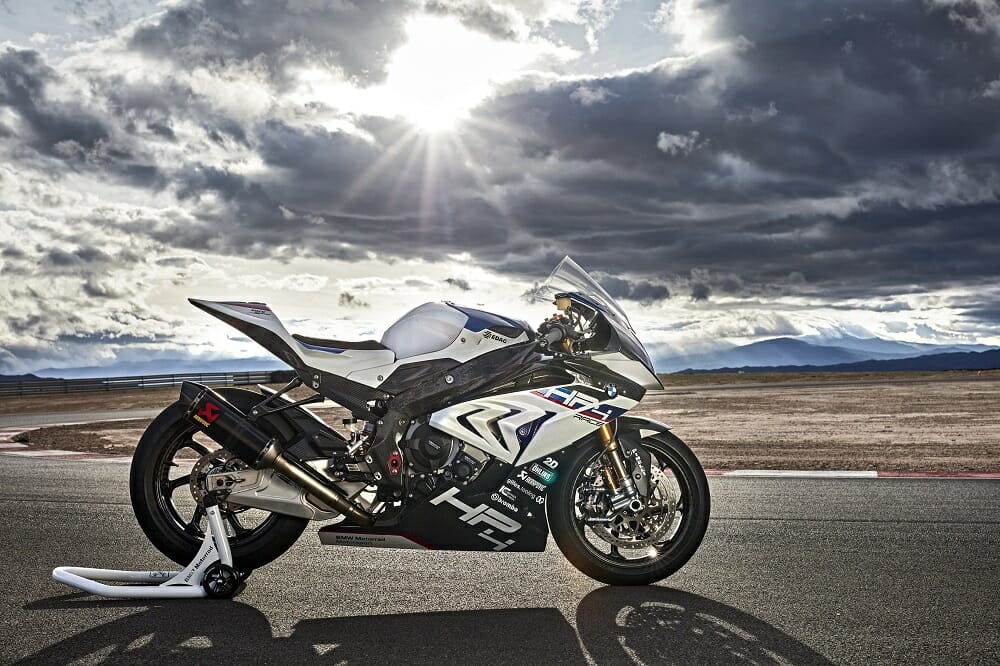 Only 750 HP4 RACEs will be manufactured, sold to customers around the globe at a hefty price of $91,000, but only as a track-ready road racer, not as a street-legal motorcycle.
Only 750 HP4 RACEs will be manufactured, sold to customers around the globe at a hefty price of $91,000, but only as a track-ready road racer, not as a street-legal motorcycle.
BMW’s automotive division has already become adept at volume manufacture of CF/carbon-fiber components, beginning with its i3 electric car, of which up to the end of last year more than 65,000 units had been sold since deliveries began in November 2013. This, like BMW’s exotic plug-in hybrid i8 sports car, employs a light and resilient carbon-fiber frame in which its passenger cell, zero emissions powertrain and the batteries powering this are all installed, thus compensating for those batteries’ extra weight.
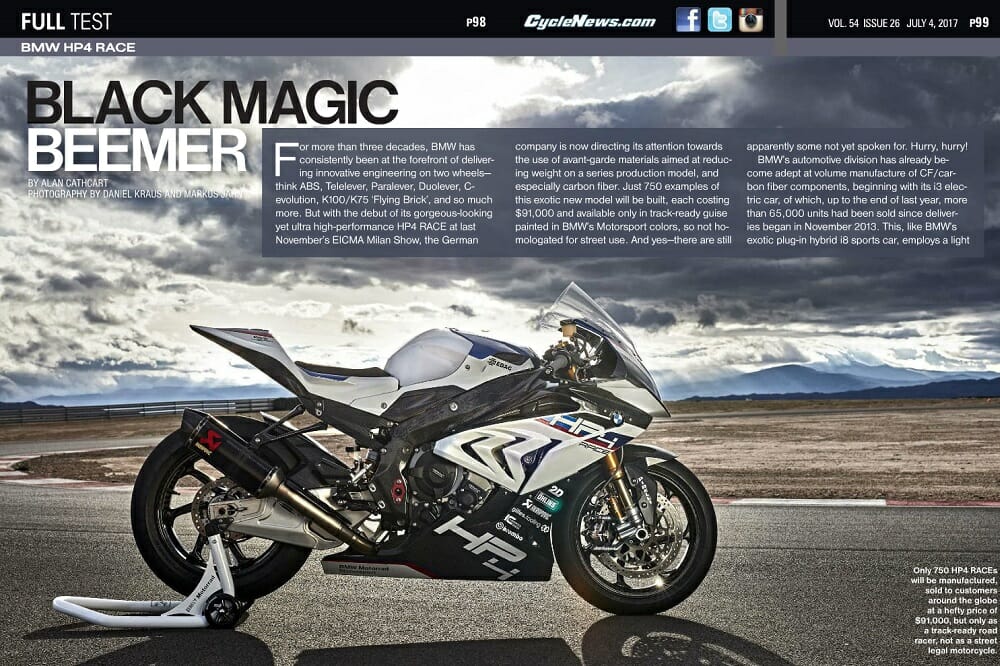
PHOTOGRAPHY BY DANIEL KRAUS AND MARKUS JAHN
BMW Motorrad has now adapted the RTM/Resin Transfer Moulding manufacturing system entailed in creating the i3 EV to a two-wheeled application, thus becoming the first motorcycle manufacturer in the world to develop a conventional twin-spar frame made entirely of carbon fiber—and one moreover that thanks to RTM is feasible to construct on a volume production basis, with each frame made identical one to another.
“The industrially produced carbon-fiber frame of the new HP4 RACE opens a whole new chapter in motorcycle chassis construction,” says Christian Gonschor, Project Manager for the HP4 RACE. “In it we are bringing together optimum technical qualities, consistent manufacturing quality and [economic affordability] for the first time.”
That’s because the RTM system no longer requires each CF component to be baked for anything up to 30 hours in a pressurized autoclave oven, instead reducing manufacturing time to minutes rather than hours, depending on the complexity and size of the component. It’s also much less labor intensive, too, because instead of patiently layering up CF sheeting by hand, the RTM process entails using ready-made, ready-shaped CF felt that’s laid into a mold, then injected with resin.
In fact, BMW has adopted three different CF manufacturing techniques to create the HP4 RACE, which is in effect a Black Magic revival of the HP4 high end street bike introduced in 2012 and sold for three short years, before it was replaced in 2015 by the current generation S100RR. But in addition, the track-focused HP4 RACE is powered instead by a more powerful 215-bhp version of the S1000RR Superbike race motor used by Jordi Torres to lead Race 2 at the Misano round of the 2017 World Superbike series for so many laps just four days before I was invited to ride the HP4 RACE at Portugal’s Estoril GP circuit, outside Lisbon. Except, even with an identical engine, Jordi’s BMW Superbike is heavier than the carbon-framed HP4 RACE I rode, which scales an amazing 321 pound dry, or 376 pound track-ready with its 4.6 gallon aluminum fuel tank fully fueled—compared to the racer’s 370 pounds with oil/water, but no fuel.
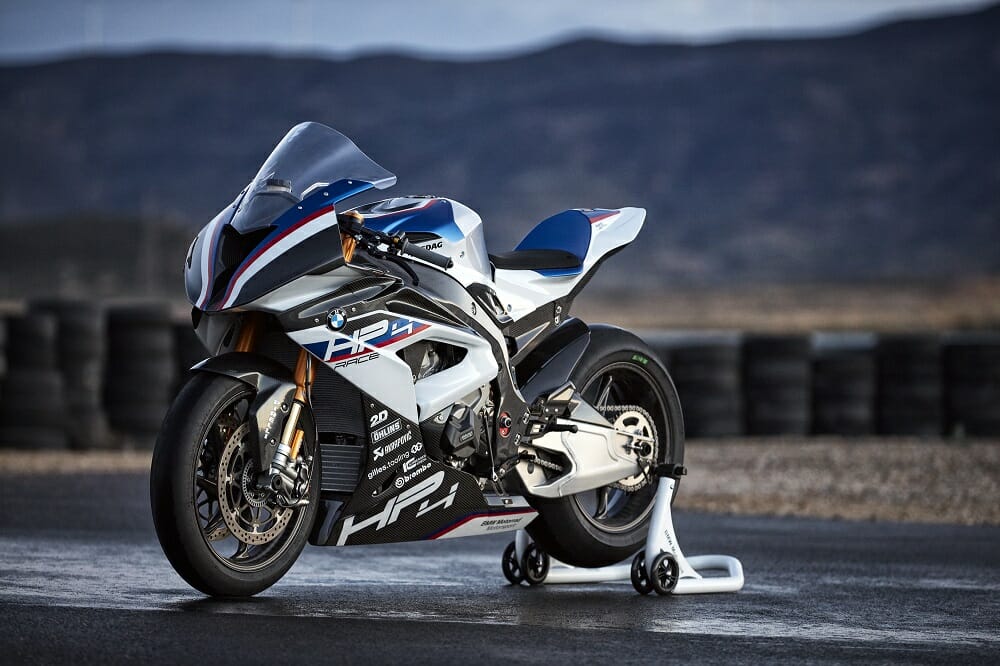 Ultra lightweight materials reduce weight to an amazing 322 pounds dry, including carbon-fiber twin-spar hollow monocoque frame, wheels, mudguards, bodywork and covers.
Ultra lightweight materials reduce weight to an amazing 322 pounds dry, including carbon-fiber twin-spar hollow monocoque frame, wheels, mudguards, bodywork and covers.
Key elements in that weight saving are the CF frame, subframe and wheels, for the chassis in which the four-cylinder in-line engine is integrated as a load-bearing element, scales a mere 171 pounds complete with bulkhead partitions and metal inserts, which are bonded into it at the manufacturing stage for long-term durability. That’s a huge 8.8 pounds lighter than the S1000RR’s cast aluminum chassis, and the CF frame is moreover a one-piece hollow monocoque construction made from a single piece of material, and thus has no seams, no joints, and no neuralgic weak points, such as individually bonded or bolted-on components. Yet according to Christian Gonschor, it does indeed have a degree of controlled flex engineered in at design stage, to deliver the critical responsiveness and dynamic feedback that an over-stiff chassis doesn’t convey.
The self-supporting CF seat subframe is also made via RTM, and is adjustable for three different heights varying in 15mm increments from 816mm to 846mm, while the milled aluminum footrests are also eight-way adjustable for position. You can’t not get comfortable in it. The CF wheels are 30% lighter than conventional forged aluminum ones, and offer a significant 40% reduction in gyroscopic weight, which translates into much improved steering, plus enhanced acceleration and braking. That’s because there’s less rotational inertia, thus helping improve acceleration—which is why all top-level drag racers use CF wheels—as well as braking, with less overall weight to stop and start. But interestingly, BMW’s adoption of carbon fiber as the new aluminum didn’t extend to the HP4 RACE’s swingarm, which is indeed still made of—aluminum.
“By the time we’d inserted all the metal fixtures we needed to incorporate in the carbon-fiber swingarm, there wasn’t sufficient material left to justify making it in carbon fiber,” says Gonschor. “So we didn’t!”
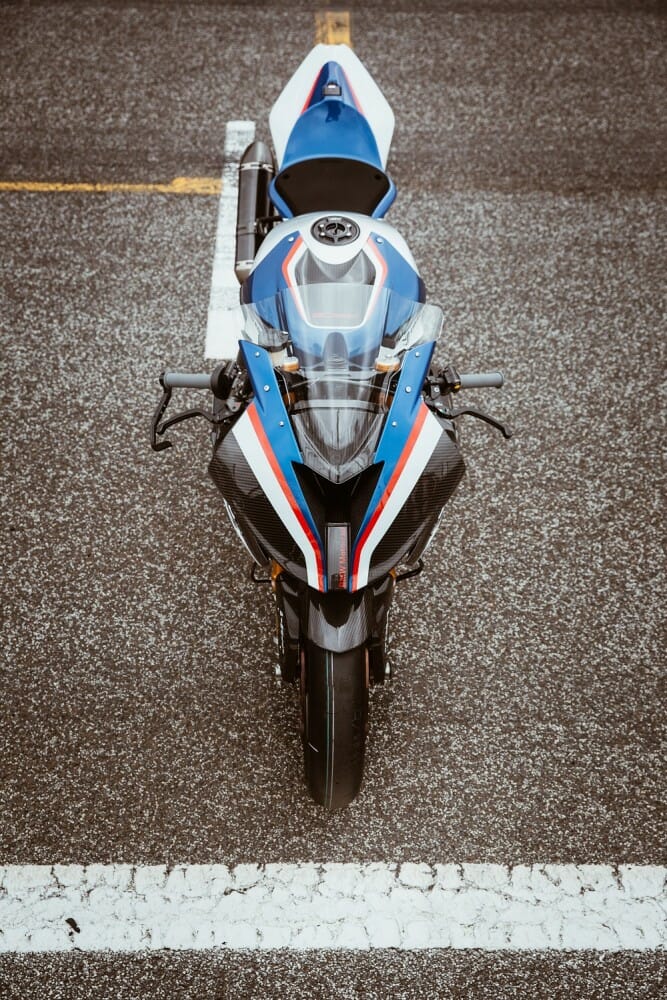 RTM/Resin Transfer Molding manufacturing system developed on BMW’s i3 electric car allows volume production of carbon-fiber components, each identical one to another.
RTM/Resin Transfer Molding manufacturing system developed on BMW’s i3 electric car allows volume production of carbon-fiber components, each identical one to another.
But while it’s the HP4 RACE’s glitzy array of exotic CF hardware that grabs your attention first and foremost, that’s only because it’s so self-evident—whereas lurking behind all that is a stealth fighter of a mechanical package that combines scintillating performance with MotoGP-level componentry, to create a motorcycle that’s amazingly close in performance and feel to a factory superbike. I rode the factory S1000RR Superbike each year that BMW contested the World Superbike series, the last time at Imola in 2013 on Chaz Davies’ GoldBet bike in the final season of BMW’s five-year plan to win the World title (PS: they didn’t!), and my first lap of Estoril on the HP4 RACE was like shaking hands with an old friend you hadn’t seen for a while, even down to the spacious yet accommodating riding position, without excessive weight on your arms or shoulders.
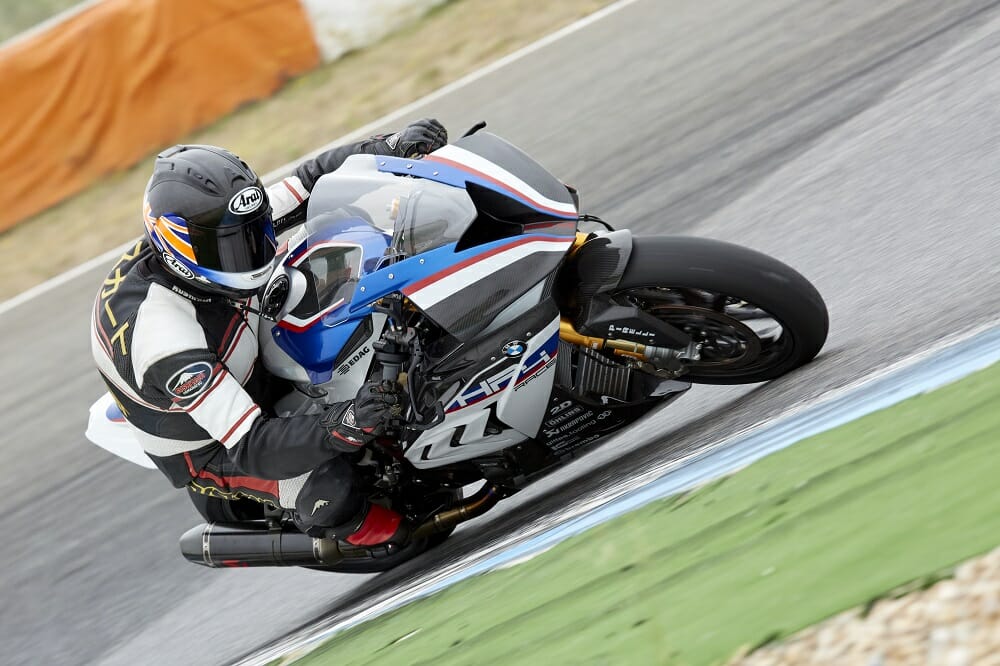 The unique benefits of carbon-fiber components in steering and handling was fully experienced at Estoril.
The unique benefits of carbon-fiber components in steering and handling was fully experienced at Estoril.
For even though the WorldSBK rules have been tightened up since then to bring the engines especially closer to stock, the HP4 RACE has the same explosive, irresistible acceleration and heaps of straight line performance that I can remember Chaz’s S1000RR Superbike had. With peak power of 215 bhp/158 kW at 13,900 rpm, and maximum torque of 120Nm delivered at 10,000 revs, this engine is a considerable step up from the 193-bhp HP4 that debuted five years ago, and is easily the most powerful BMW motorcycle ever offered for customer purchase. The revlimiter has been raised an extra 300 revs to 14,500 rpm, and as I found each lap I’d exit the fast, fast third-gear sweeper leading on to the Estoril main straight in a vain attempt to pretend I was Toni Elias depriving Valentino Rossi of his 2006 MotoGP world title by beating him to the line there by a wheel for his one and only GP victory. It pays to rev the BMW engine out to the limiter, because there’s definitely more power available up high. So you can ignore the array of flashing red lights across the top of the ultra-legible 2D dash telling you to hit another gear until just before the RBW throttle stops building power, and you can tap the sweet-action race-pattern gearshift to hit fourth gear as you start to straighten up and fly right down that long, long front straight.
Yet that huge amount of horsepower is delivered in such a linear, usable way, coupled with an unlikely degree of forgivingness and flexibility. That’s thanks to the variable length intake system, revised intake and exhaust camshafts, and closed-up gear ratios, with a higher first and second gear, unlike the Ducati 1299 Superleggera it can’t help but be compared with, this isn’t a street bike, so there are no stoplights you have to accelerate away from out on the racetrack, and thus no need for a street-friendly low first gear. There’s the same third-gear ratio as before, and a lower top three. Coupled with the flawless gearshift combining both a wide-open powershifter to keep the bike revving, and a well-dialed-in auto-blipper for clutchless downshifts, so that you don’t ever have to use the clutch lever again after you’ve moved away from rest. This makes riding the HP4 RACE a thrilling experience even before taking into account the benefits of all those missing pounds wafted away by the extensive use of carbon fiber.
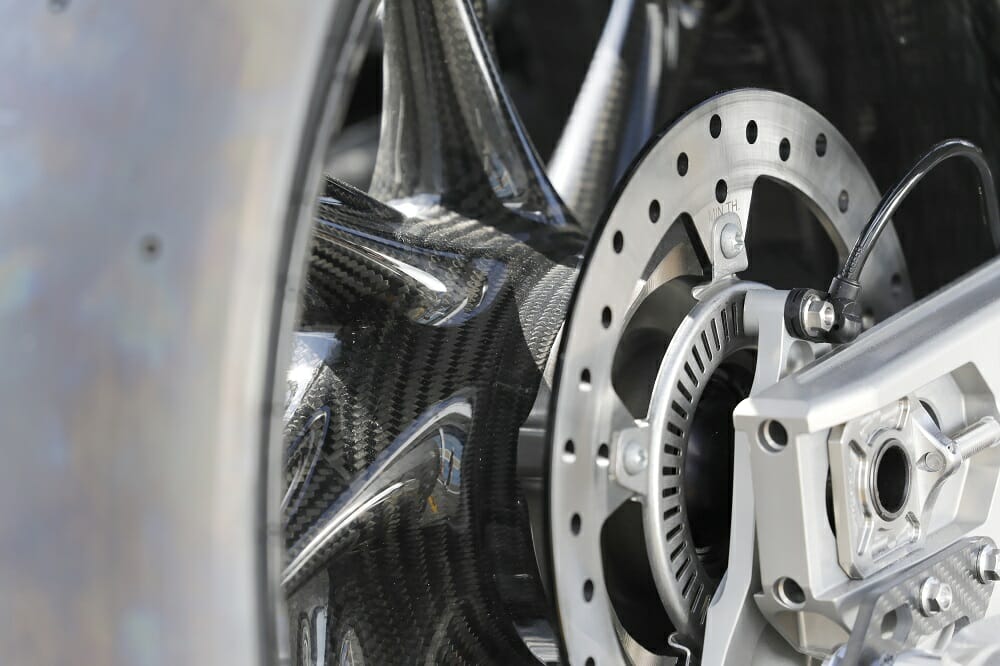 The swingarm is aluminum not carbon fiber because requisite metal inserts didn’t leave space for viable loss of weight.
The swingarm is aluminum not carbon fiber because requisite metal inserts didn’t leave space for viable loss of weight.
No more thrilling than when you have to stop hard, hard, hard for the second-gear right-hander at the end of the main straight at Estoril from flat out in fifth gear. I’ll readily admit I never quite managed to pull a true top gear on the long gearing BMW had fitted—and have to start flirting with the 650-foot board at speeds well over 174 mph. Each lap I tried to be a little braver and eke out an extra yard or two, five even, exploiting the phenomenal braking potential of the Brembo GP4PR Monoblock calipers with titanium pistons that are de rigueur for most of the field in both MotoGP and WorldSBK grids. These are easily the most effective brakes I’ve ever experienced on a production motorcycle, and yet they’re easy to modulate in slower bends if you want to just ease off a little velocity because you got over-ambitious with maintaining turn speed. Plus by working the accessible and easily-understood button pads on either handlebar to dial in a little more of the 15-stage engine braking that can be varied for each gear ratio, I was able to get some extra help from the motor in slowing down, without at the same time creating any instability. Nice.
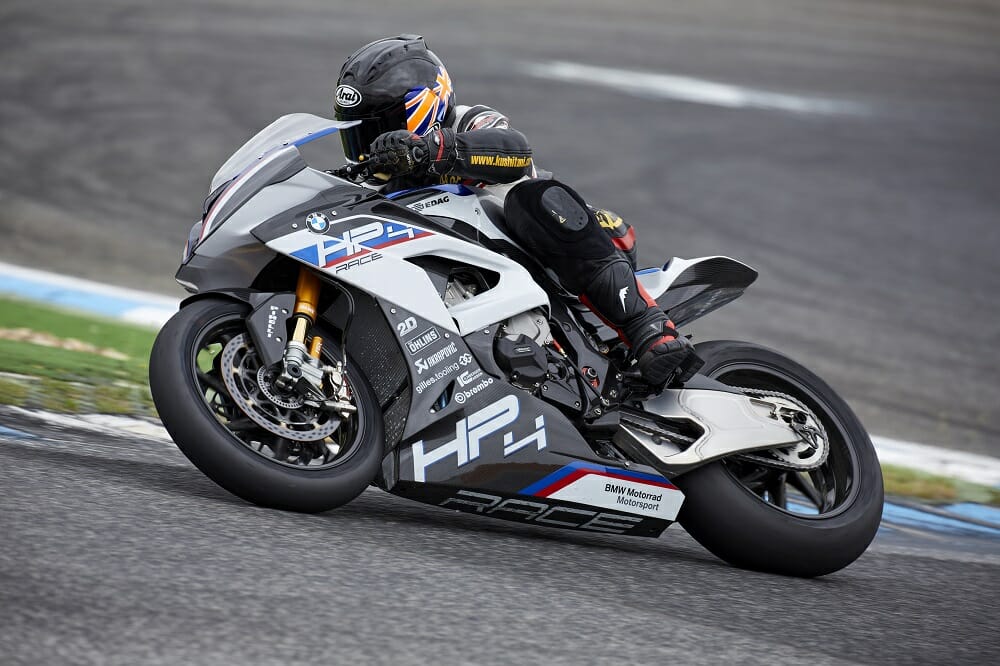 Outstanding Brembo MotoGP/WSBK brakes deliver outstanding stopping power, while Öhlins suspension is equally superlative in compliance and feel.
Outstanding Brembo MotoGP/WSBK brakes deliver outstanding stopping power, while Öhlins suspension is equally superlative in compliance and feel.
Also 15-stage programmable is the HP4 RACE’s DTC/traction control, which literally speaks to you via an audible staccato chatter as it intervenes by cutting the ignition via cylinder suppression patterns of varying strength, depending on the degree of rear wheel slip. The Intermediate riding mode I started with out of the four available (Wet, Intermediate, Dry1, Dry2) had the TC cutting in very frequently, even with the grippy SC2 compound chosen for the Pirelli Diablo Superbike Slick tires fitted. Moving to Dry1 was much more rational, though, once again, you can fine tune the settings for each gear in each of the four modes. Same thing for BMW’s programmable Wheelie Control, while the other electronic features include Launch Control and a Pit Lane speed limiter. Also MotoGP/WSBK derived are the 43mm Öhlins FGR300 upside-down fork and the Swedish suspension sultan’s TTX36 GP rear shock, both of course fully adjustable.
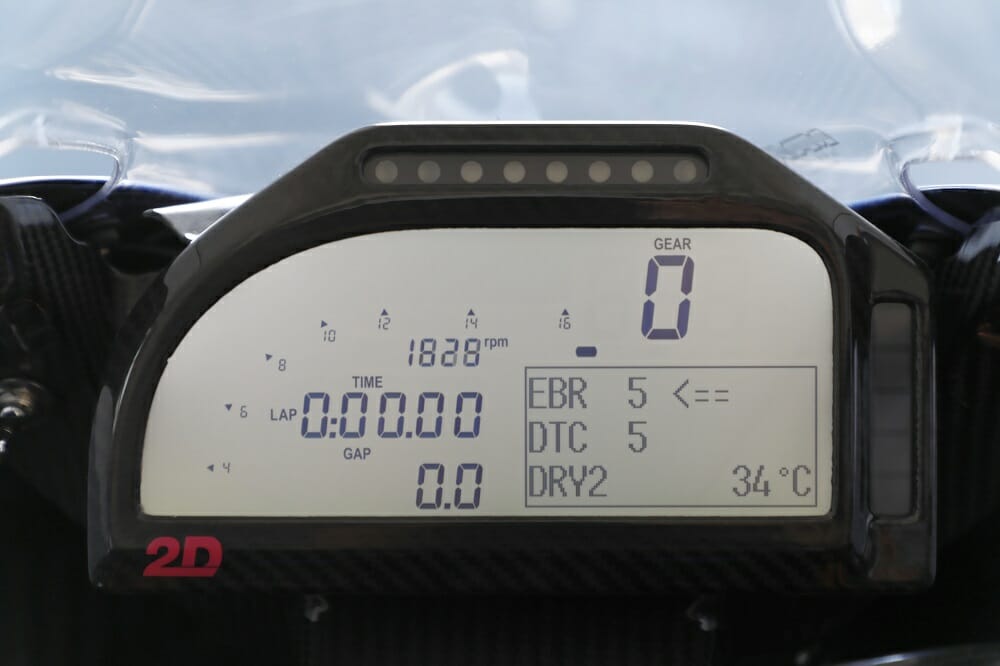 Usual array of BMW-developed electronic programs is accessible and functional, with audible intervention of traction control via staccato chatter.
Usual array of BMW-developed electronic programs is accessible and functional, with audible intervention of traction control via staccato chatter.
Yet hard, though, it is to ignore the extra power and greater torque of this fabulous engine, it’s the very refined handling of the BMW HP4 RACE that really impresses, thanks to its lightweight and especially those carbon wheels. Try as I might to prepare myself after spending my first session at Estoril riding a 2017-model S1000RR street bike fitted with the same Pirelli slicks as the HP4, after hopping aboard that bike, I found myself to begin with doing the same thing I’d done a month earlier when riding the comparable Ducati 1299 Superleggera at Mugello, also equipped with carbon wheels. I’d keep over steering into the apex of a turn, especially at Estoril’s slow uphill chicane, requiring me repeatedly to pick the BMW up again, and correct my line. I’ve been riding on carbon wheels ever since 1994, when I began helping Dymag develop such a design by racing on them, so I know how greatly they influence turn-in and steering, and I always recognize you have to be ready to compensate for them. You must focus on using a lighter touch in steering the bike, which I’d honestly thought I was doing. But then I realized that I hadn’t taken into account the even lighter weight of the new BMW’s carbon-fiber frame compared to its S1000RR street bike sister’s aluminum chassis I’d been riding earlier, as well as all the copious other black magic bits on this uber-lightweight motorcycle
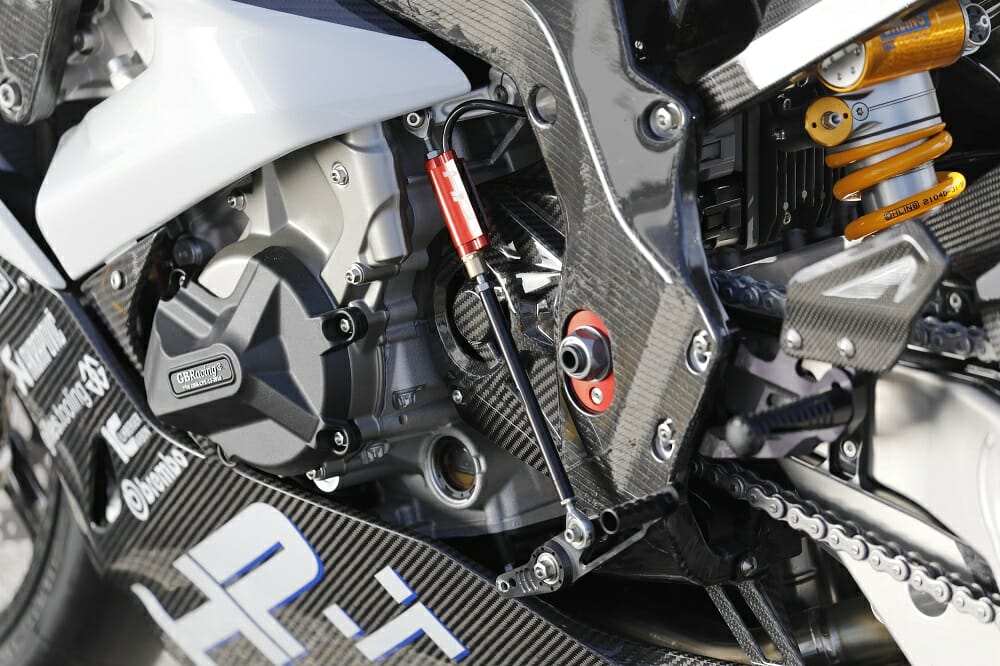 Ultra short-stroke 999cc engine measuring 80 x 49.7mm and built to WorldSBK specs produces 215 bhp at 13,900 rpm, delivers scintillating performance.
Ultra short-stroke 999cc engine measuring 80 x 49.7mm and built to WorldSBK specs produces 215 bhp at 13,900 rpm, delivers scintillating performance.
This made the HP4 RACE’s steering ultra-light, especially when flicking from side to side in the complex of corners from Turn 1 onwards at Estoril, yet without sacrificing stability on the faster bends. Truly the best of both worlds—the lighter carbon-fiber chassis structure and all the other CF parts definitely make the new BMW more nimble and responsive as well as less tiring in changing direction, especially at lower speeds, when it turns super-easily and hugs your chosen line tightly. This bike is faster steering and more agile than any other four-cylinder superbike I’ve yet ridden, making it too bad that BMW can’t homologate it for WorldSBK!
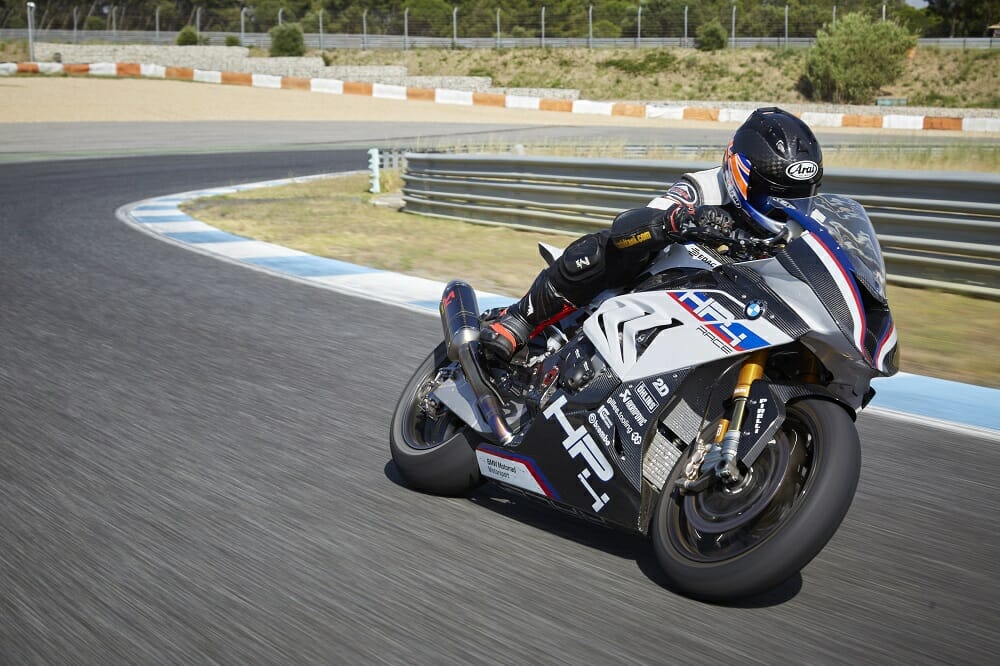 The HP4 RACE is BMW’s fastest and most powerful customer motorcycle yet offered for sale by the German manufacturer.
The HP4 RACE is BMW’s fastest and most powerful customer motorcycle yet offered for sale by the German manufacturer.
Carbon-framed motorcycles are like buses: you wait three decades for another one—ever since the first such bike, the Armstrong CF250 road racer that debuted at the 1984 British GP at Silverstone—and then three come along one after another, each quite different one than another. First was last year’s surprise packet, the Dutch-built VanderHeide with its carbon monocoque chassis incorporating the 6.3 gallon fuel tank, then came the 500-off Ducati 1299 Superleggera with its vestigial carbon semi-monocoque that’s really just a CF airbox used as a structural entity, and now perhaps most relevant of all for future applications comes this BMW, with a conventional twin-spar frame made in carbon rather than metal, but using a manufacturing technique that makes it cost-effective to commercialize. BMW Motorrad has chosen to start at the top by using carbon fiber extensively to produce the highest-performance customer-available motorcycle money can buy, with the performance of a factory Superbike racer. But it’s inevitable that the economies of scale will see a trickle-down effect that’ll result in BMW’s CF technology being applied to other models in its range. So what’s next—maybe a G310R-based HP1 RACE? Don’t laugh, it may very well happen! CN
|
SPECIFICATIONS: BMW HP4 RACE ($91,000)
|
|
ENGINE:
|
Water-cooled, DOHC, in-line 4-cylinder, 4-valves per cylinder
|
|
DISPLACEMENT:
|
999cc
|
|
BORE X STROKE:
|
80 x 49.7cc
|
|
COMPRESSION RATIO:
|
13.9:1
|
|
TRANSMISSION:
|
Constant-mesh, 6-speed
|
|
CLUTCH:
|
Multi-plate, anti-hopping, wet
|
|
TRACTION CONTROL:
|
DTC 15-level adjustment
|
|
FRAME:
|
Carbin fiber, monocoque RTM frame
w/ adjustable steering head angle
|
|
FRONT SUSPENSION:
|
Ohlins, FGR 300 Superbike World Cup, fully adjustable
|
|
REAR SUSPENSION:
|
Aluminum underslung double-sided swingarm, Ohlins TTX36 GP single shock, fully adjustable
|
|
FRONT WHEEL:
|
3.50 x 17 in., carbon fiber
|
|
REAR WHEEL:
|
6.00 x 17 in., carbon fiber
|
|
FRONT TIRE:
|
120/70 ZR 17 Pirelli Diablo Superbike Slick SC2
|
|
REAR TIRE:
|
200/60 ZR 17 Pirelli Diabolo Superbike Slick SC2
|
|
FRONT BRAKE:
|
Brembo Racing twin disc, 320mm, 4-piston
|
|
REAR BRAKE:
|
Brembo Racing single disc, 220mm,
4-piston Superbike World Cup fixed
|
|
SEAT HEIGHT:
|
32.1/33.3 in.
|
|
FUEL CAPACITY:
|
4.6 gal.
|
|
DRY WEIGHT:
|
322 lbs.
|